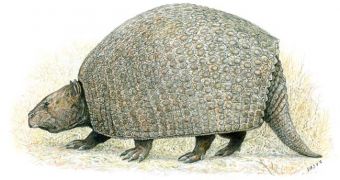You could not put this one into an armadillo race. In fact, you could not hold it. That's because ancient armadillos were really big. Now, an American team has described in the "Journal of Vertebrate Paleontology" a new large fossil species based on a partial skeleton discovered up in the Andes in northern Chile. The new species lived 18 million years ago, and the fossils were found in 2004.
"When we collected this fossil, we had no idea that it would turn out to be a new species. We knew that it would be an important specimen, given its completeness, but it was only after careful comparison to other known species that we realized how unusual it was", said lead researcher Darin Croft, of Case Western Reserve University in Ohio.
The new species, dubbed Parapropalaehoplophorus septentrionalis, was part of a now extinct armadillo family called Glyptodontidae. But while armadillos have some jointed mobile plates on their back, glyptodonts resembled turtles with their mostly immovable plates. And they were much bigger than their modern relatives.
P. septentrionalis had a weight of about 200 pounds (90 kg), as much as an average black bear, and still was a dwarf compared with its relatives, some of which were up to 4,000 pounds (1,814 kilograms) heavy, 1.5 m (5 ft) tall and about 3.6 m (12 ft) long, as big as a rhinoceros.
The new species is a new member of the "Chucal Fauna", a group of about 18 mammal species encountered in Chilean region Salar de Surire. The Chucal fauna also comprised marsupials and rodents, while the plant fossils point that the area was a steppe with very few trees during the period when P. septentrionalis lived. 18 million years ago, the Andes were just 3,000 ft (914 m) above sea level, a quarter of the current height of the modern Andes.
"Our sites are now located more than 14,500 feet above sea level, but when these animals were alive the region was at much lower elevations. That means that the Chucal fossils give us a unique insight into the timing and rate of uplift of the high Andes", said co-author John Flynn, a paleontologist of the American Museum of Natural History in New York.

 14 DAY TRIAL //
14 DAY TRIAL //